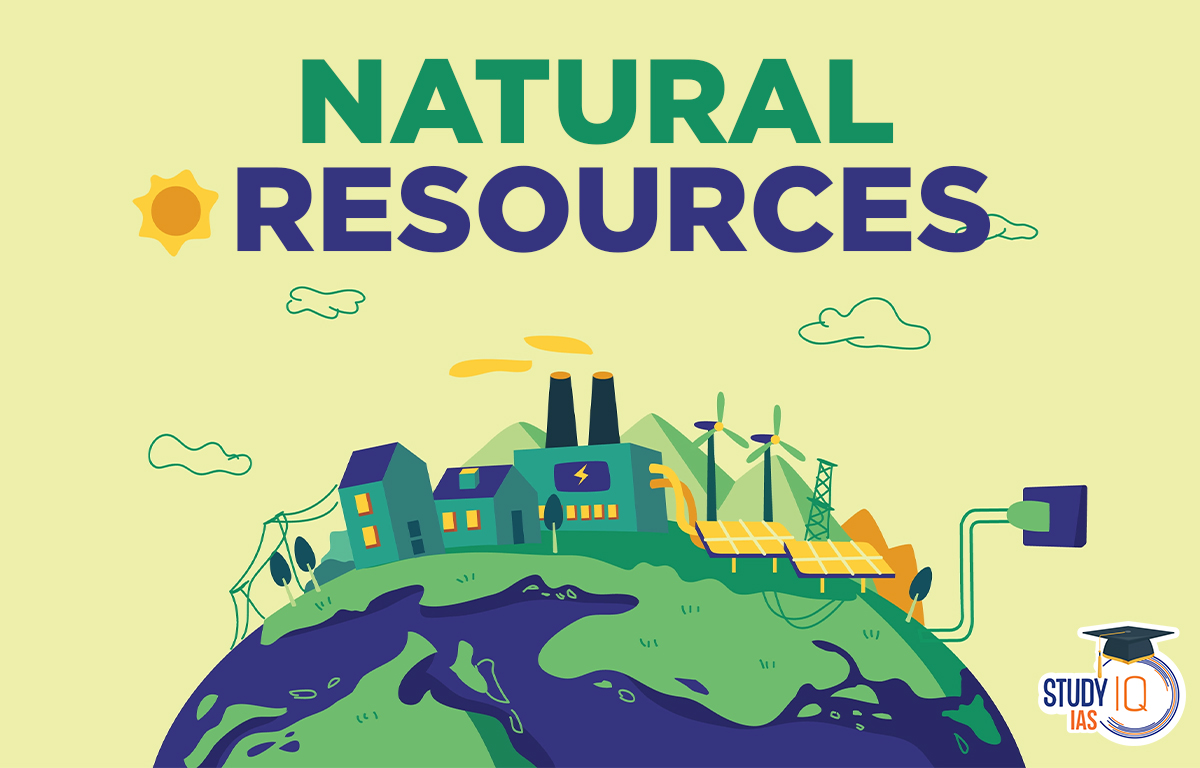Table of Contents
Natural resources are things from nature that people use, like animals, soil, minerals, wood, and water. These are considered gifts of nature. Unlike manufactured goods, natural resources come directly from the environment. They also include important services that nature provides which help support life and economic activities. This article will explore India’s natural resources, providing valuable information for geography studies and the UPSC Civil Service exam.
What are Natural Resources?
- Water: Includes rivers, lakes, groundwater, and oceans, which are essential for drinking, agriculture, and industry.
- Minerals: These include metals like iron, copper, gold, and silver, as well as non-metallic minerals like sand, gravel, and salt, used in construction, manufacturing, and various products.
- Fossil Fuels: Consists of coal, oil, and natural gas, which are primary sources of energy for electricity, heating, and transportation.
- Land: Refers to arable land for farming, forests for timber and biodiversity, and wildlife habitats that support various species.
- Biotic Resources: Includes fish, wildlife, and forests, which provide food, materials, and ecological balance.
- Energy Resources: Covers renewable sources like wind, solar, and geothermal energy, as well as nuclear energy, all crucial for sustainable power generation.
- Soil: Represents fertile land necessary for growing crops and supporting agriculture.
Natural Resources Types
Depending on their place of origin, natural resources can be grouped in many different ways.
- Biotic Resources
- Abiotic Resources
A biotic resource is any living part of the environment. Examples include forests, crops, birds, animals, fish, and other marine life. These resources are renewable because they can replenish and reproduce themselves. However, even though coal and mineral oil come from biological sources, they cannot be replenished.
Abiotic resources are non-living parts of the environment. Examples include land, water, air, and minerals like iron, copper, gold, and silver. These resources are limited and non-renewable because they cannot be reproduced or regenerated. Natural resources can be grouped based on how quickly they can recover.
- Non-Conventional
- Conventional
There are two categories of natural resources depending on availability:
- Renewable resources are those that are any time available and can be utilised in a variety of ways. Examples include a forest, wind, and water.
- Non-renewable resources are those whose supply is limited or whose availability might diminish in the future. Minerals and fossil fuels are a few examples.
Natural Resources Examples
The following are the Top 5 Natural Resources such as:
| Type | Details |
| Air | For all plants, animals, and humans to exist in our world, the air they breathe must be clean. Therefore, action must be taken to lower air pollution. |
| Water | Only 2% of the water on Earth, which covers 70% of the planet, is fresh water. It is important to take steps to educate the public and control water use. |
| Soil | Different particles and nutrients make up soil. It promotes plant growth. |
| Iron | Silica is a mineral that contains iron, which is utilised to make powerful weapons, vehicles, and construction materials. |
| Forests | Forests maintain the world’s environment and offer clean air. Trees are taken down for housing and building projects. |
Natural Resources List
Natural resources are materials or substances that occur naturally in the environment and can be used for economic gain. Here is a list of some common natural resources:
| Natural Resources | Details |
| Water | This includes freshwater bodies like rivers, lakes, and groundwater, as well as saltwater bodies like oceans. |
| Minerals | These are naturally occurring substances that are solid and inorganic. Examples include gold, silver, iron, copper, coal, and diamonds. |
| Forests | Forests provide various resources such as timber, medicinal plants, and habitats for diverse flora and fauna. |
| Fossil Fuels | These include coal, oil, and natural gas, which are formed from organic matter over millions of years and are used for energy production. |
| Air | While it might seem abundant, clean air is a crucial natural resource for sustaining life and supporting ecosystems. |
| Soil | Soil is essential for agriculture and provides a medium for plant growth. It also hosts a variety of organisms and plays a role in nutrient cycling. |
| Fish and Wildlife | These include living organisms such as fish, birds, mammals, and other wildlife that are harvested for food, recreation, and other purposes. |
| Renewable Energy Sources | Resources like sunlight (solar energy), wind, geothermal heat, and biomass can be harnessed for energy production. |
| Biodiversity | Biodiversity itself is a natural resource as it provides genetic diversity, ecosystem services, and resilience to environmental changes. |
| Land | Land resources include areas suitable for agriculture, urban development, conservation, and other purposes. |
| Metal Ores | These are naturally occurring compounds from which metals can be extracted, such as bauxite for aluminum and hematite for iron. |
| Freshwater Resources |
Besides water bodies, freshwater resources include aquifers and underground reservoirs. |
| Geothermal Energy | Heat from within the Earth can be harnessed for various purposes, including electricity generation and heating. |
| Renewable Biomass |
Biomass resources include wood, agricultural residues, and organic waste, which can be converted into biofuels or used for heating and electricity generation. |
| Sunlight |
Solar energy is a clean and renewable resource that can be harnessed using photovoltaic cells for electricity generation and solar thermal collectors for heating. |
Status of Natural Resources in India:
- India has fertile soil, forests, minerals, and water, but they are unevenly distributed.
- Rapid population growth leads to overuse of resources like logging and overfishing.
- The Northern Great Plains and Brahmaputra Valley grow crops like wheat, rice, and sugarcane.
- India has diverse natural vegetation and wildlife due to its varied climate and relief.
- Cover 24.5% of the land, providing firewood, paper, spices, and more, contributing significantly to GDP.
- India has extensive marine and inland water resources, with an 8129 km coastline and rich inland fisheries.
- India’s total oil reserves were 258.96 million metric tons (MMT).
- The oil and gas industry began in 1889 with discoveries in Assam; the natural gas industry started in the 1960s.
- Total Crude oil processed during June 2024 was 22.2 MMT which is 3.1% higher than June 2023,
- India imports 82% of its oil needs, aiming to reduce this to 67% by 2022 through local exploration and renewable energy.
- Major natural gas production comes from the Mumbai High complex and onshore fields in Assam, Andhra Pradesh, and Gujarat.
- India has large mineral resources, including iron, coal, manganese, bauxite, and more.
- Livestock farming is significant, with many goats, sheep, poultry, cattle, and buffalo.
- India has diverse agro-climatic conditions supporting various horticultural crops.
- Coal is the main energy source, found in states like Andhra Pradesh, Chhattisgarh, and Odisha.
- Natural gas is available in Tripura, the Krishna Godavari field, and associated with petroleum products.
- India ranks fourth in the world for iron ore production, contributing about 7% of global production.
Natural Resources Importance
Natural resources are of great importance to human societies for many reasons. Here are some key reasons why natural resources are important:
- Economic Importance: Many natural resources are essential for economic development. For example, minerals and fossil fuels are crucial for industry and transportation, and timber is important for the construction of buildings and furniture. Agriculture is also dependent on natural resources, such as water and fertile soil, which are used to grow crops.
- Energy Production: Natural resources are also used to generate energy. Fossil fuels, for example, are burned to produce electricity, while wind and solar energy are harnessed to generate clean energy.
- Environmental Importance: Natural resources are important for maintaining the balance of ecosystems and providing habitats for wildlife. Forests, for example, are home to many plant and animal species, and they also help to prevent soil erosion and regulate the climate.
- Social Importance: Natural resources can provide a source of livelihood for many people. For example, fishing and forestry provide jobs and income for many communities around the world.
- Cultural Importance: Natural resources also have cultural significance for many societies. For example, indigenous cultures often have a deep connection to the land and rely on natural resources for their traditional way of life.
Natural Resources UPSC
Natural resources are things that occur naturally and are essential for human survival and development. The natural sciences have long dealt with natural resources. These are environmental resources that have been found or developed naturally. Natural resources include, among other things, air, sunlight, water, soil, rock, plants, animals, and fossil fuels. You will learn about India’s natural resources in this article, which will help you study geography for the UPSC Civil Service exam.


 Story of Meera Bai and Her Devotion For ...
Story of Meera Bai and Her Devotion For ...
 Iron Ore, Types, Uses, Distribution in I...
Iron Ore, Types, Uses, Distribution in I...
 Low Pressure System and Madden-Julian Os...
Low Pressure System and Madden-Julian Os...





















